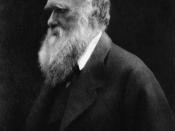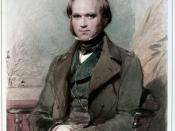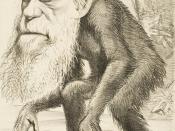On December 27, 1831, the HMS Beagle set sail, bringing Charles Robert Darwin from his home in England to many places in the Americas to study the land and the organisms that lived on it. His most famous stop was at the Galapagos Islands. Here he found related yet different species of plants and animals on each island. One example is the finches he observed, with beaks ranging from large to very fine (http://clab.cecil.cc. md.us/faculty/biology1/DARWIN.HTM). He realized that these variations had to do with how the organism lived. If the bird fed on large seeds, then it had a large beak. If the bird fed on small seeds, then it had a small beak, and so on. He found other examples of this phenomenon comparing creatures on the mainland to those on the islands. He then concluded that this was due to adaptation, and that all organisms descend from other, slightly different species, that this process went back to the beginning of life on earth, and that it will continue.
At the end of his voyage, after he returned to England, he wrote a brief summary of his ideas which became known to a few scientists, but he mostly moved on to study in other fields. It was not until 1956 when he began to formally write his theory of evolution by means of natural selection, which resulted in Darwin?s famous The Origin of Species by Means of Natural Selection (http://clab.cecil.cc.md.us/faculty/ biology1/ DARWIN.HTM). Throughout the years, Darwin had several works published, including The Decent of Man, and The Power of Movement in Plants (Porter and Graham, p.xxii). On April 19th, 1882, at Down, Charles Darwin died, and was buried in Westminster Abbey (Porter and Graham, p.xxii). During the late 19th century, as these works were published, many groups of people...


